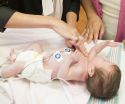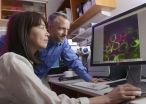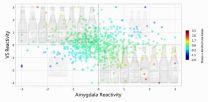(Press-News.org) Premature babies are at an increased risk for developing autism spectrum disorder. But a small study indicates that preemies who avoid eye contact in early infancy are less likely to demonstrate symptoms of autism at age 2 than preemies who maintain eye contact during early interactions, according to new research at Washington University School of Medicine in St. Louis.
"Children with autism typically have challenges with social interaction and may avoid eye contact, but it turned out that children in this study who had characteristics of autism at age 2 were more likely to maintain eye contact and not avert their gazes in early infancy," said first author Bobbi Pineda, PhD, assistant professor in occupational therapy and in pediatrics.
The research is available in the July/August issue of The American Journal of Occupational Therapy.
Early intervention can benefit children with autism spectrum disorder. However, while signs of autism have been observed in infants as early as two to six months of age, the disorder is difficult to diagnose before age 2.
In the new study, the researchers observed behavioral symptoms characteristic of autism in a particularly high-risk group of young children: those born prematurely. Observing early behaviors may give researchers and clinicians indicators to look for early in life so they can recommend timely diagnostic testing and interventions to improve a baby's adaptive responses and outcome.
The researchers evaluated 62 premature infants hospitalized in the neonatal intensive care unit (NICU) at St. Louis Children's Hospital. The infants were born at least 10 weeks before they reached full term and were evaluated close to the dates they were supposed to have been born.
The researchers focused on whether the infants made eye contact or averted their gazes; responded to objects or people around them; interacted socially; and calmed themselves when upset. They also looked at whether the babies exhibited a horizontal repetitive eye movement called nystagmus.
Of the 62 preemies, 58 were observed for visual cues; the others were asleep during visits from the researchers. Of those 58 babies, 41 averted their gazes, and 21 showed nystagmus. Nearly all of the infants with nystagmus -- 19 -- also averted their gazes.
When the babies in the study were screened for autism at age 2, using a recognized screening checklist for autism in toddlers, 13 -- or 21 percent -- screened positive. A positive finding indicates a child is at risk and should receive diagnostic testing. The researchers were surprised to find that many of the babies who had averted their gazes and showed signs of nystagmus as infants did not display warning signs of autism at age 2.
"Surprisingly, we found that the children who later screened positive for autism were more likely as infants to not avert their gazes during social interaction," Pineda said. "They were more likely to sustain eye contact."
Pineda speculated that premature infants in the NICU may avert their gazes as a coping mechanism to help them deal with the stress of an intense environment during a vulnerable period of development. So absence of gaze aversion, she said, could signal an inability to avoid stressors.
"This could explain why some infants behave differently in social interactions as babies than later, as children," Pineda said. "Better understanding how autism traits emerge along the developmental pathway is an important area for future research."
With nearly one in 68 children in the U.S. diagnosed with autism, according to the Centers for Disease Control and Prevention, Pineda and her colleagues hope the new study will motivate researchers to better define differences in development across the lifespan, including the neonatal period.
Screening tools for autism spectrum disorder don't exist for infants, but research is needed to improve understanding of how autism traits emerge, she said. This would help pave the way for early interventions aimed at improving life skills and allowing those with autism to lead more productive lives.
INFORMATION:
This work was supported by the National Institutes of Health (NIH), grant number ROI HD 057098; the Washington University Intellectual and Developmental Disabilities Research Center, via NIH, grant number P30 HD062171; the National Center for Advancing Translational Sciences, grant number UL1 TR000448, sub award KL2 TR000450; the Comprehensive Opportunities for Rehabilitation Research K12 award, K12 HD055931.
Pineda R, Melchior K, Oberle S, Inder T, Rogers C. Assessment of Autism Symptoms During the Neonatal Period: Is There Early Evidence of Autism Risk? The American Journal of Occupational Therapy. July/August 2015 edition.
Washington University School of Medicine's 2,100 employed and volunteer faculty physicians also are the medical staff of Barnes-Jewish and St. Louis Children's hospitals. The School of Medicine is one of the leading medical research, teaching and patient-care institutions in the nation, currently ranked sixth in the nation by U.S. News & World Report. Through its affiliations with Barnes-Jewish and St. Louis Children's hospitals, the School of Medicine is linked to BJC HealthCare.
ROSEMONT, Ill.--Participation in sports by women and girls has increased from 310,000 individuals in 1971 to 3.37 million in 2010. At the same time, sports-related injuries among female athletes have skyrocketed. According to a new study in the Journal of the American Academy of Orthopaedic Surgeons (JAAOS), women with symptoms known as the "female athlete triad" are at greater risk of bone stress injuries and fractures.
"The female athlete triad is a spectrum of symptoms that include low energy availability, menstrual cycle abnormalities, and low bone mineral density. ...
There may be far fewer galaxies further out in the universe then might be expected, according to a new study led by Michigan State University.
Over the years, the Hubble Space Telescope has allowed astronomers to look deep into the universe. The long view stirred theories of untold thousands of distant, faint galaxies. The new research, appearing in the current issue of the Astrophysical Journal Letters, however, offers a theory that reduces the estimated number of the most distant galaxies by 10 to 100 times.
"Our work suggests that there are far fewer faint galaxies ...
People have evolved to be smarter and taller than their predecessors, a study of populations around the world suggests.
Those who are born to parents from diverse genetic backgrounds tend to be taller and have sharper thinking skills than others, the major international study has found.
Researchers analysed health and genetic information from more than 100 studies carried out around the world. These included details on more than 350,000 people from urban and rural communities.
The team found that greater genetic diversity is linked to increased height. It is also ...
The European Space Agency's Rosetta spacecraft first began orbiting comet 67P/Churyumov-Gerasimenko in August 2014. Almost immediately, scientists began to wonder about several surprisingly deep, almost perfectly circular pits on the comet's surface. Now, a new study based on close-up imagery taken by Rosetta suggests that these pits are sinkholes, formed when ices beneath the comet's surface sublimate, or turn directly to gas.
The study, which appears in the July 2, 2015 issue of the journal Nature, reveals that the surface of 67P/Churyumov-Gerasimenko is variable and ...
DALLAS - July 1, 2015 - UT Southwestern Medical Center scientists collaborating with University of Michigan researchers have found a previously unidentified mechanism that helps explain why stem cells undergo self-renewing divisions but their offspring do not.
Adult stem cells provide a ready supply of new cells needed for tissue homeostasis throughout the life of an organism. Specialized environments called "niches" help to maintain stem cells in an undifferentiated and self-renewing state. Cells that comprise the niche produce signals and growth factors essential for ...
DURHAM, N.C. - A pair of brain-imaging studies suggest researchers may be able to predict how likely young adults are to develop problem drinking or engage in risky sexual behavior in response to stress.
The new research is part of the ongoing Duke Neurogenetics Study (DNS), which began in 2010 to better understand how interactions between the brain, genome and environment shape risky behaviors that can predict mental illnesses including depression, anxiety, and addiction.
"By knowing the biology that predicts risk, we hope to eventually change the biology -- or at ...
GeoSpace
Beijing quadrupled in size in a decade, new study finds
Researchers tracked the changing physical infrastructure in Beijing, China, and found that the city's physical area quadrupled between 2000 and 2009, according to a new study published in Journal of Geophysical Research: Atmospheres.
Eos.org
Seismic Hazard Assessment: Honing the Debate, Testing the Models
Earthquake experts learn that "take a hike" isn't an insult, but a way to resolve hotly debated scientific issues. The scientists found common ground by trekking over it.
New research papers
Disappearance ...
For decades, researchers in the genetics field have theorized that the protein spools around which DNA is wound, histones, remain constant in the brain, never changing after development in the womb. Now, researchers from the Icahn School of Medicine at Mount Sinai have discovered that histones are steadily replaced in brain cells throughout life - a process which helps to switch genes on and off. This histone replacement, known as turnover, enables our genetic machinery to adapt to our environment by prompting gene expression, the conversion of genes into the proteins that ...
Washington, D.C., July 1, 2015--The vast majority of consumers recognize that multivitamins, calcium and/or vitamin D supplements can help fill nutrient gaps but should not be viewed as replacements for a healthy diet, according to a new survey conducted on behalf of the Council for Responsible Nutrition (CRN). Conclusions from the survey of more than 2,000 U.S. adults were published in Nutrition Journal in a peer-reviewed article titled, "Consumer attitudes about the role of multivitamins and other dietary supplements: report of a survey," authored by CRN consultant Annette ...
Neurons in a brain region called the medial temporal lobe play a key role in our ability to quickly form memories about real-life events and experiences, according to a study published July 1st in Neuron. By recording from individual neurons in patients, the researchers reveal for the first time in humans the single-cell basis for the creation of episodic memories.
"It was impressive to see how individual neurons signalled the learning of new contextual associations between people and places and that the changes in firing could occur just after one instance," says lead ...




